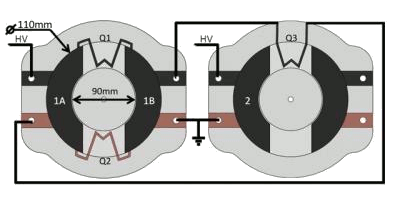Environmental Energy Harvesting
April 19, 2011
Our
natural environment abounds with
energy, and much of it can be
harvested to power
electronic devices. I've written about energy harvesting technologies is some recent articles, as listed below:
• Green Braking, October 20, 2010
• Pyroelectric Energy Harvesting, October 15, 2010
• Flutter Power, August 17, 2010
• Hot Bodies, July 22, 2010
The following table summarizes the sources of environmental energy, and how much of this energy we can harvest.[1] It's not surprising that
solar energy tops the list. Solar energy has powered all the
biological processes on Earth for more than
three billion years.
Our energy demands are decidedly
anthropocentric,
cellphones stuck in our ears and the like, so a logical application of energy harvesting is to derive energy from our bodies and our own movements. Our
metabolic chemical factory processes a lot of energy; for example, the energy obtained from a
jelly doughnut (330 "
food calories") is 1.38
MJ. Estimates of harvestable energy content for various human activities were listed in a 1996 paper by
Thad Starner, who was then at the
MIT Media Laboratory.[2] These included
• Body Heat 2.4 - 4.8 W
• Blood Pressure 370 mW
• Exhalation 400 mW
• Breathing (Total) 830 mW
• Chest Band (Breathing) 0.42 W
• Arm Motion 0.33 W
• Finger Motion 0.76 - 2.1 mW
• Footfalls 5.0 - 8.3 W
One human energy harvesting application that's been around for as long as I can remember is the
"self-winding" mechanical watch. This technology was tweaked with the advent of digital watches to comprise a
voltage generator powered by the same wrist movements. An alternative energy harvesting design was the
Seiko Thermic wristwatch, which used ten
thermoelectric modules to generate a microwatt or so from the small thermal gradient between body and ambient temperature.[3]
Some proof-of-concept systems have been done for shoes,[3] and the less obvious case of mechanical stress on the
fabric in the clothes that we wear.[4-6] In the later case, researchers at the
University of California, Berkeley, prepared
nanofibers of the
piezoelectric polyvinylidene fluoride (PVDF) that could be woven into garments. The fibers, which had diameters as small as 500 nanometers, were found to generate up to 30 millivolts and 3 nanoamps under
mechanical strain at a
conversion efficiency of about twelve percent.[4-5] These data correspond to a maximum power of
P = EI = (3 x 10-2)(3 x 10-9) = 9 x 10-11 watt,
or about 100 picowatts. If we can sum the power of a thousand of these fibers, we could obtain a power of 100 nanowatts, or 0.1 microwatt. Actually, the most likely architecture would be many longer fibers that would accomplish the same task with fewer interconnects. This is still a very small amount of power, so more work needs to be done. In contrast, the shoe generator gives us about five watts.
Recently, researchers from the Biomimetics Laboratory and Department of Engineering Science of the
The University of Auckland (New Zealand) and Industrial Research Limited, also of
Auckland, have published a different approach to human energy harvesting in
Applied Physics Letters.[7-8] They use
dielectric elastomers, stretchable materials that are called "
artificial muscles."
The Auckland elastomer devices had a generating capacity of about 10 mJ/g, and they were able to convert mechanical work to electricity with a 12% efficiency. These energy harvesters are inexpensive, and their combination of softness, flexibility and low
mass make them ideal for many environmental energy harvesting applications. They can be inserted into clothing to provide energy from human movement, and it appears they can generate more power than the piezoelectric nanofibers.

Schematic of the physical layout of the soft generator.
(Image: American Institute of Physics)
![]()
References:
- Haluk Külah and Khalil Najaf, "Energy Scavenging From Low-Frequency Vibrations by Using Frequency Up-Conversion for Wireless Sensor Applications," IEEE Sensors Journal, vol.. 8, no. 3 (March, 2008), pp. 261-268.
- Starner, T., “Human-Powered Wearable Computing,” IBM Systems Journal, Vol. 35, No. 3&4, 1996, pp. 618-629. Also available here.
- Joseph A. Paradiso, "Systems for Human-Powered Mobile Computing," IEEE Design Automation Conference (San Francisco, CA, July 24-26), pp. 645-650.
- Sarah Yang, "New fiber nanogenerators could lead to electric clothing," University of California at Berkeley Press Release, February 12, 2010.
- Chieh Chang, Van H. Tran, Junbo Wang, Yiin-Kuen Fuh and Liwei Lin, "Direct-Write Piezoelectric Polymeric Nanogenerator with High Energy Conversion Efficiency," Nano Letters, vol. 10, no. 2 (February 10, 2010), pp. 363-750).
- Raghu Das, "Applying energy harvesters to textiles," Energy Harvesting Journal, March 31, 2011.
- Charles Blue, "Replacing batteries may become a thing of the past, thanks to soft generators," American Institute of Physics Press Release, April 6, 2011.
- Thomas G. McKay, Benjamin M. O’Brien, Emilio P. Calius and Iain A. Anderson, "Soft generators using dielectric elastomers," Applied Physics Letters, vol. 98, no. 14 (April 5, 2011), Document 142903 (3 pages).
Permanent Link to this article
Linked Keywords: Natural environment; energy; energy harvesting; electronic; solar energy; biological; timeline of evolution; vibration; acoustic noise; diurnal temperature cycle; temperature gradient; lithium battery; anthropocentric; cellphone; metabolism; jelly doughnut; food calorie; Joule; Thad Starner; MIT Media Laboratory; thermoregulation; body heat; blood pressure; exhalation; breathing; self-winding mechanical watch; voltage generator; Seiko; thermoelectric generator; fabric; University of California, Berkeley; nanofiber; piezoelectric; polyvinylidene fluoride; PVDF; mechanical strain; energy conversion efficiency; The University of Auckland (New Zealand); Auckland; Applied Physics Letters; dielectric; elastomer; electroactive polymer; artificial muscle; mass.